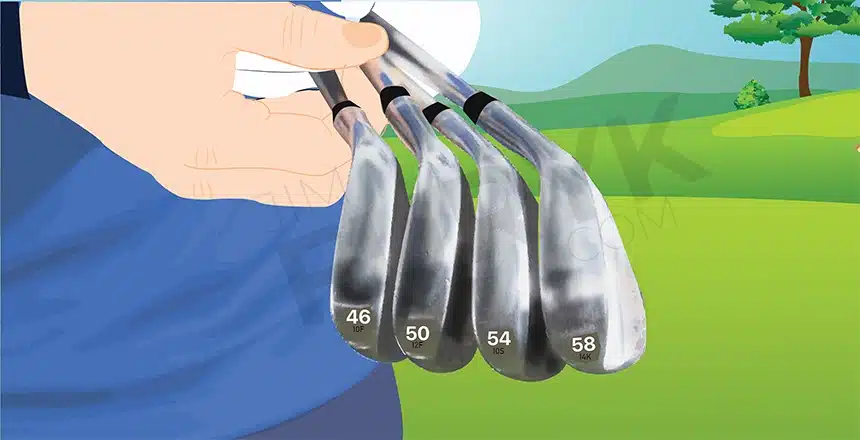Scoring clubs, that’s what wedges are in the game of golf. You may have seen or heard about golfers, who once used to carry 1-2 wedges, now opting for a 3-4 wedge setup. The simple reason for that – the more wedges you carry in your golf bag, the more your ‘greenside’ play options increase.
Think of it this way, unobstructed shots with greater roll and shots where the ball gets in the air and then quickly stops – both situations demand the use of two different wedges. In that case, what are the various types of wedges in golf? Does every player need to use/carry them? You’ll know this and more by the time you’re done with the article!
In This Post
Golf Wedges Explained – An Overview
If you look at these packaged sets of golf clubs, you’ll see how every one of them comes with at least one wedge, which is mostly the pitching wedge. However, this isn’t the only wedge there is. You can also buy a sand wedge, lob wedge, and gap wedge. All are crafted with different loft angles, hence each is used for a different purpose.
With wedges, you have to know that these golf clubs feature the highest loft in the set. They’re specifically designed for hitting short approach shorts within 120 yards, pitch shots, chip shots, shots played out of sand bunkers, and basically any shot that demands the ascending of the ball with a sharp descent.
Top Golf Shots You Can Hit Using a Wedge
1. Pitch Shot: The pitch shot is a high trajectory shot that travels a short distance. This shot is made using a wedge by positioning the ball in the center of the stance and swinging the club with a shorter backswing. It’s a useful shot for getting the ball up and over obstacles while also landing it softly on the green.
2. Bump-and-Run: This is a low trajectory shot that covers a long distance with minimum flight time in the air. It is usually used when the golfer wants to run the ball up to the green surface with a shallow trajectory, without causing much backspin. To hit the bump-and-run shot with a wedge, you need to play the ball toward the back of your stance and hit down on it with some wrist action.
3. Flop Shot: The flop shot is a high lofted shot that is used to hit over objects like trees and bunkers or to stop the ball quickly on the green. It is difficult to execute but can be mastered with the right technique. By opening the clubface and positioning the ball towards the front of your stance, you can get the ball to pop up high and land softly.
4. Sand Shot: (also known as a bunker shot) Wedges are primarily designed to hit sand shots well. A sand shot requires the golfer to hit the sand behind the ball and blast the sand out from under the ball to propel it into the air and onto the green surface. Sand shots are tricky, but with the proper technique, wedges can help you get out of a tough sand trap situation.
5. Lob Shot: The lob shot is an ultra-high, ultra-short shot designed to travel straight up in the air and land abruptly. It is often used as a “get out of jail” shot when the golfer has no other option. To execute this shot with a wedge, you need to open the clubface and play the ball toward the back of your stance for a more vertical launch angle.
In conclusion, wedges are essential clubs in a golfer’s bag and can be used to hit a variety of shots around the green. By mastering these shots, you can increase your chances of scoring well on the golf course.
Different Types of Golf Wedges
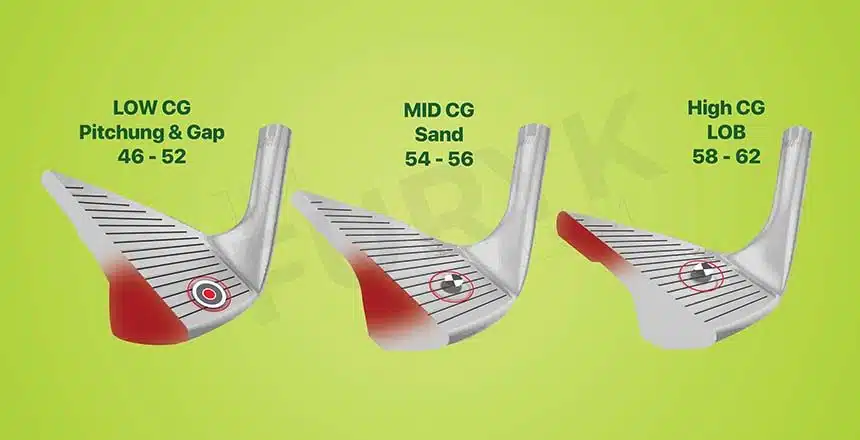
Not every wedge is fitted with the same degree of loft. Different loft angles are used, so each golf wedge is made to hit a certain kind of shot. On that note, here are all the various types of wedges you can use to get the most out of your short game situation…
Pitching Wedge (PW)
Pitching wedge loft angle is 46–48 degrees.
PW is the wedge with the lowest loft. As long as you know how to hit a pitching wedge, you can go for a full swing to achieve a distance between 110 yards and 140 yards, or for long-range chip shots.

Sand Wedge (SW)
Sand wedge loft angle is 54–58 degrees.
The sand wedge is designed for getting the golf ball out of rough and sand traps. The higher loft here is precisely what helps with popping the ball up while also reducing spin.
It’s best used within 80-110 yards from that target pin.

Gap Wedge or Approach Wedge (AW)
Gap or approach wedge loft angle is 48–54 degrees.
This particular wedge fills the gap between a sand wedge and a pitching wedge. The distance you can generate with the help of a gap or approach wedge is 90-110 yards.
A full swing is possible here instead of softening your approach via PW or hitting more aggressively with your SW.

Lob Wedge (LW)
Lob wedge loft angle is 59–65 degrees.
It’s got the highest loft for getting your shots airborne quickly with minimal travel. The best lob wedges out there are very effective when you want to navigate obstacles, hit flop shots, or shots within 80 yards.

Features of Wedges That Matter the Most
How do golf wedges affect your game? They do it through several factors, such as the following…
1. Loft

The degree loft of golf clubs is the angle at which the clubface tilts. A higher loft automatically means a higher ball flight, but distance gets compromised.
Loft angle plays a major role in drivers, putters, and even more so in wedges. Just because of that, there should be proper, uniform gapping in the loft angles across your wedge setup. This should happen irrespective of how many wedges you carry. Be it 3 or 4, the loft spacing should be even, so there’s no inconsistency throughout your golf club set (meaning your every type of shot is covered).
As for the ideal wedge loft setup, here it is…
- Pitching wedge: 46-48 degrees
- Sand wedge: 56 degrees
- Gap wedge: 50-52 degrees
- Lob wedge: 60 degrees
Such a setup consists of a gap of 4 degrees to 6 degrees between any two wedges, thus your every single approach shot is covered, no matter the lie or distance.
2. Bounce
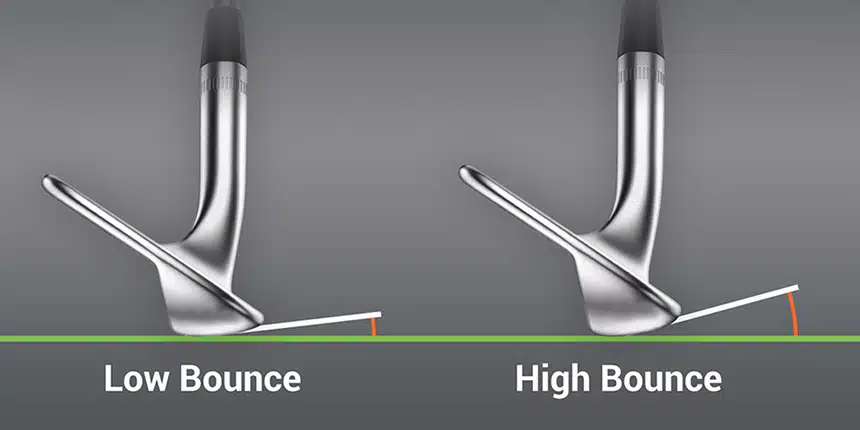
Little attention is given to the bounce angle of wedges and I don’t understand why that is because it’s the very bounce of the golf club that strikes the ground. It’s the angle that’s between the sole of the club and the turf.
So what is the most fitting bounce angle for your swing speed and type? Also, course conditions play a part. So here are different bounce options you can select from…
- Low Bounce
The bounce angle is between 0 and 10 degrees.
Best for firm conditions and tight lies, low bounce is mainly a part of wedges with a lower loft angle i.e. pitching wedge and gap wedge. The combination of low loft and low bounce ensures that the wedge gets under the ball cleanly and produces longer shots.
A sweeping golf swing and shallow angle of attack – both situations demand to be tackled with a low-bounce wedge.
- Mid or Standard Bounce
The bounce angle is between 10 and 16 degrees.
Best for more versatility out of your short game, thus you can play this one from a wide range of conditions. Since the bounce angle is standard-issue, it’s the most appropriate wedge to pull out when your attack angle is average too.
- High Bounce
The bounce angle is higher than 16 degrees.
These are very specialized wedges that are sure to get your golf ball out of fine, soft sand and extremely soft turf as well. When the bounce is higher, you dig less through your swing to form a way smoother plane. Mostly, players chose high bounce when their angle of attack is steep. (Wait, what does this ‘angle of attack’ mean?)
3. Leading Edge and Sole
The clubface has a lower boundary or edge where it comes in contact with the bottom or sole. Then there’s the trailing edge too which consists of the bottom and the behind section of the sole.
You end up with low-flight, weak shots when it’s the leading edge that makes contact with the golf ball. Rather you ought to be striking downward to get both the leading edge and also the trailing edge to enable ground contact evenly. This way, the sole just glides across the turf instead of digging in.
4. Grooves
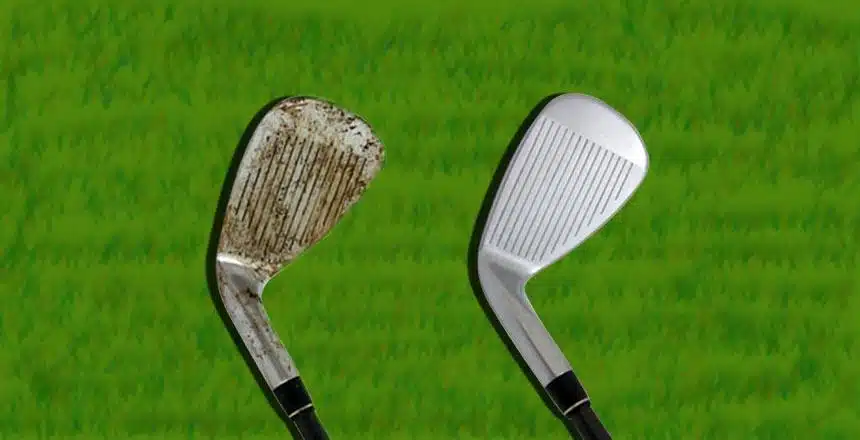
The purpose of grooves built into the wedge clubface is to allow clean and consistent contact with the ball every single time. Grooves are also very adept at keeping away unwanted particles/elements from the clubface, such as dirt, debris, moisture, etc. Much like the tires of a car!
Furthermore, wedge grooves boost backspin, which increases flight time, hence distance. They provide more shot trajectory control, greater ball-stopping power, and shorter near-the-pin rollout.
Although you might want to know that both R&A and USGA have banned using wedges with deep grooves since they give you the upper hand in terms of producing more backspin. Hence, the restriction is placed on groove volume and even the edge radius in wedges. In turn, this results in less backspin, but the launch angle is higher.
In that case, the only two wedge grooves allowed are vintage finish and laser-etched. The former, when it rusts, leaves the metal with an intrinsic feel and sound. While laser-etching paves the way for maximum spin, these types of grooves don’t adjust based on your striking and playing tendencies in the long run (vintage finish grooves do).
However, both grooves are susceptible to wearing out and/or becoming dull when not sharpened once every few rounds of golf. So if you know how to clean your golf clubs properly and regularly, you can actually inspect the grooves and also keep them clean.
5. Sole Grind
The grinding of the soles is done so that each wedge feels more customized to a certain playing technique. For instance, there’s the heel grind, which ensures an open clubface to hit flop shots with extra height. And it does so by getting rid of material from the heel of the wedge. Likewise, there are different wedge sole grind options to suit specific playing conditions.
Although, unlike accurate, consistent measurements such as loft angle, bounce angle, etc., sole grinds are not uniform across all brands. Even though that heel grind setting will offer much the same flexibility as far as shot-making is concerned, the chances of a heel grind from a certain manufacturer being more suitable for you than the others by different brands are quite high.
6. Shaft Material and Flex
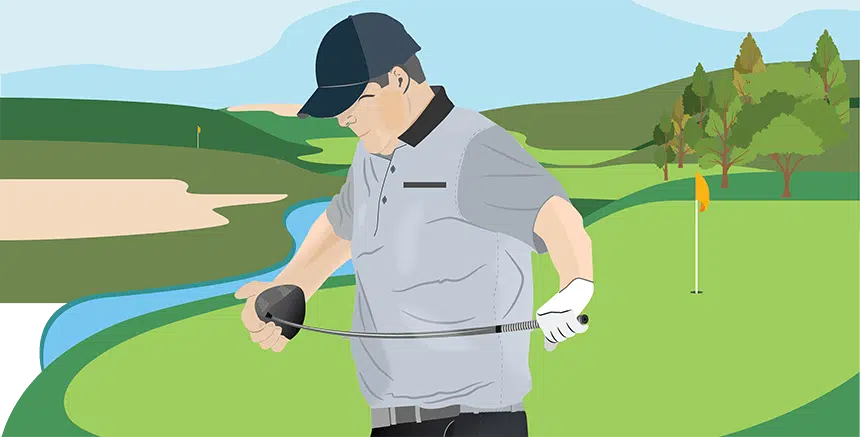
Time to talk about shaft construction.
You have graphite vs steel shafts where graphite is more lightweight and flexible, thus easier to hit if your swing speed is slow.
On the other hand, steel shafts, because of the stiffer, heavier properties, are more geared toward faster swing speeds. Also, steel enables you to gain greater shot precision through increased clubhead control, whereas graphite promotes a higher swing speed and extra power at the cost of control.
You find graphite shafts mostly on drivers. As for wedges, the choice of shaft material here depends on what you prefer and also on the shaft of the irons you use (so consistency isn’t compromised from club to club). But you can pick graphite for irons to boost distance and then steel for wedges for the sole purpose of improving control.
Lastly, putters always come fitted with steel shafts to enhance precision and control.
Moving on to shaft flex now, it’s how much the shaft bends during your swing. Choosing the right shaft flex also depends on your game. In the case of wedge shafts, these are more flexible and lighter in the tip section (close to the clubhead). Such a construction flicks that clubhead very subtly at the golf ball to create more backspin and improve trajectory.
Golf wedge shaft flex has a lot to do with how frequently you take 3/4 and full swings. For 3/4 swings using the pitching wedge, having more stiffness i.e. less flex in this particular wedge than the lob wedge is a more workable situation. However, less flex won’t work for the greater power of full swings. So it’s better if your pitching wedge and irons have the same shaft flex.
Now here are the general shaft flex options based on how much distance your drives cover…
- Ladies Flex: More often than not, women golfers drive the golf ball below 200 yards. That is why they choose drivers specifically engineered for carrying the ball farther.
- Senior Flex: Driving distance between 180 yards and 200 yards, mostly achieved by men above 50 years of age. Thus, the most forgiving golf drivers for seniors.
- Regular Flex: These are mid-range to high-range handicappers driving the ball 200-250 yards.
- Wedge Flex: This shaft flex is only slightly stiff and made for medium to low handicappers who choose irons with a stiff shaft flex.
- Stiff Flex: These are also for mid-to-low handicap players who can generate driving distances between 250 yards and 300 yards.
- Extra Stiff Flex: This one’s for you if you’re able to hit drives over 300 yards long!
7. Distance Gapping
We talked about loft spacing, now let’s move on to a more relevant and specific topic i.e. distance gapping.
Loft angle plays a major role in the matter of distance, right? However, it’s not the only determinant, your set of skills and strengths also count. In your golf bag, there must be a mix of different wedges and irons, maybe not from the same manufacturer also. As a result, this mixing and matching changes variables, which has an impact on shot distance.
Even if, let’s assume, you choose a single wedge set, but then the way you swing those wedges is different, there will be distance gaps between your golf clubs. Therefore, average distances i.e. how far you hit your wedges get compromised.
I think now is the right time to discuss swing velocity – an important factor that affects distance, but it’s not within golf club control. Rather swing velocity has to do with how fast or slow you swing your clubs.
A golfer with a higher swing velocity and one with a slower swing velocity, using a similar wedge setup that has a uniform loft gapping of 4 degrees, will not have the same distance gapping.
Higher swing velocities equal greater distance gaps, while slower swing velocities create a comparatively smaller distance gap from club to club because of the tighter range of their shots. Hence, the latter can freely increase loft spacing to 6 degrees.
8. Club Fitting
If you want to optimize your wedge performance, always prioritize club fitting. It’s crucial that the wedges you use match your style of play, only then can you aim for lowering your golf scores.
Club fitting entails knowing the standard length/size of golf clubs and also choosing the correct loft angle and bounce setting. All of these factors combine to give you a quality wedge that will actually rescue you from sand traps, strike the best chip shots, and do a lot more to get you to complete your 18-hole round of golf with better scores.
How many golf wedges should you have in your bag?
One of the frequently asked questions in golf is how many wedges a player should have in their bag. The answer to this question varies depending on a player’s skill level, preferences, and the golf course they play on. However, there are some general guidelines to follow. For beginners or high handicappers, carrying 2 wedges, a pitching wedge, and a sand wedge is sufficient. As you improve your skills, consider adding a gap wedge to your bag. The number of wedges you should have also depends on the loft of your current clubs. It’s important to have wedges with different lofts to fill the gaps between your clubs. Lastly, make sure to select wedges that are appropriate for the type of course conditions you normally play on.
Different Golf Wedges – FAQs
1. Which wedge is the easiest to hit?
Consistently hitting perfect shots on every lie using wedges is one of the most difficult things to do, but it gets much easier if the wedge you’re using is highly forgiving. And that would be cavity-back wedges – they make sweet spot contact consistently, so the golf ball gets airborne quickly and easily.
2. What type of wedges do beginners use?
For beginners, a pitching wedge is more than enough because lob wedges and gap wedges are for better players while carrying a sand wedge is fairly common but it’s still an additional wedge.
3. What are 58-degree and 60-degree wedges used for?
Both 58-degree and 60-degree wedges are constructed for lobbing your golf shots high into the air and then making them land on the green very softly. For chip shots, sand bunker shots, but never for full fairway shots.
Here’s how to decide between a 58-degree or 60-degree wedge if you’re an average golfer.
4. What is the sequence of golf wedges?
When dealing with wedges, there are several factors to consider. Initially, wedges’ loft may vary between 45 and 64 degrees. Pitching wedges typically have a 45-50 degree loft, while gap wedges range between 50-54 degrees in loft. On the other hand, sand wedges are lofted at 54-58 degrees, and lob wedges at 58-64 degrees.
5. Can you tell me the angle of a pitching wedge?
Golfers generally use pitching wedges, which typically have a loft ranging from 44 to 50 degrees.
6. What is the purpose of a 48-degree wedge?
Golfers typically employ Pitching Wedges for distances between 90 and 110 yards on approach shots, for low chip shots, or for lengthy sand/bunker shots. Compared to other wedge types (excluding lob wedges), Pitching Wedges provide the least amount of bounce, ranging from 2-5 degrees, enabling golfers to get under the ball to achieve substantial contact. Golfers need to be cautious with their shot execution when using a pitching wedge to avoid hitting down too hard on the ball, which will make it rise high into the sky and fall short of the green. Instead, they should take a longer backswing and concentrate on hitting the ball dead square in the center for more consistent effects.
7. What Degree Is A Gap Wedge?
Gap wedges are specially created to fill in the difference between pitching and sand wedges. Their degree of elevation typically falls between 50 and 54 degrees.
8. What is the purpose of using a wedge with a 52-degree angle?
Using a gap wedge is a useful technique to achieve a 100-yard hit. To pick the appropriate gap wedge, you should opt for a loft that is in between your pitching and sand wedges.
Gap wedges that have less loft are useful when playing from fairways or a hard surface. On the other hand, high degrees of loft is advantageous when playing on a soft fairway, deep rough, or even from a sand trap. Gap wedges are a fantastic tool to have in your golf bag as they can greatly enhance your performance.
9. What Degree Is A Sand Wedge?
Sand wedges are equipped with loft angles of approximately 54 to 58 degrees, assisting golfers in rapidly elevating the ball.
10. What is the purpose of using a wedge with a 56-degree angle?
Sand wedges are designed to assist golfers in removing their balls from the sand, although they can also be useful from a fairway or rough. The optimal distance for sand wedges is between 80 and 90 yards, and they are distinct from other wedges because they are intended to aid golfers in escaping the sand. Sand wedges have the greatest level of bounce among all wedges, ranging from 10 to 16 degrees, and the biggest sole width, indicating that the bottom of the club is built to be wider in order to prevent it from digging into the sand. So, if you happen to find yourself in a bunker, do not be concerned; instead, use your sand wedge and begin swinging.
11. What Degree Is A Lob Wedge?
Golf wedges, known as Lob wedges, are the ones with the highest degree of loft, spanning from 58 to 64 degrees.
12. What is the purpose of a wedge with a 60-degree angle?
The most flexible club you can carry in your golf bag is the lob wedge. Due to its highest loft degree, it is perfect in situations where you want to get the ball up in the air quickly. It also has a pointed edge and is slim, making it easy to scoop the ball. If you’re stuck in some deep rough or need the ball to come to a stop immediately after landing, the lob wedge is an excellent choice. If you want a club that can do everything, the lob wedge is the one you are searching for.
Conclusion
Your wedges are where you start when you want to improve not only your golf scores but also your handicap. Don’t forget that 70 percent of the shots you take in your round of golf are within 100 yards. Also, 80 percent of your golf handicap depends on these very shots!
The importance of short game often gets sidelined, but you don’t have to make such a mistake. And knowing the different types of loft angles, bounce angles, and whatnot on all the golf wedges is the first step you take to improve your short game performance.
You should always use the right wedge, meaning one that’s good for you, and not what Tiger Woods is probably using!
References:

